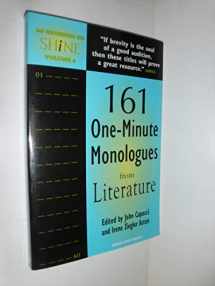
60 Seconds to Shine Volume IV: 161 One-minute Monologues from Literature
Book details
Summary
Description
This collection offers short, fresh monologues drawn from sources other than plays, and we're very happy with the wide variety of works we've gathered-161 of them-for use in auditions, classes, competitions, or simply, for your reading pleasure. But, perhaps our title is a bit misleading. Certainly, you'll find many great monologues here from "literature": novels, novellas, short stories, poems, and short-short stories. But when you search for monologue material outside the usual world of dramatic literature, you begin to see and hear-as we did-monologues everywhere: in blogs, essays, creative nonfiction, online journals, memoirs, op ed pieces, oral histories, even in e-mail spam. And all of these forms are represented in this collection. Are they all "literature"? We'll sidestep that question and simply say that each text was chosen because it is everything a monologue should be: a short, self-contained, well-written excerpt that features a unique voice or character, and contains some change in thought, emotion, or action. Each offers an intriguing glimpse into the mind or life of a captivating persona. Literature? Who cares? They're good monologues. How to use this book. At the back of this volume, you'll find all 161 monologues indexed according to age, tone, and voice, to help identify those most suited to your needs:
Age is noted exactly only when specified by the author. More often, we've indicated an age range (20s, 20s-30s). In some instances, we've used a plus sign to show the character could be older than indicated, as in 40+. Use our suggested ranges as a general guide.
Tone refers to whether a monologue falls into one of the following general categories: comic, dramatic, or seriocomic.
Voice refers to indications of class, geography, ethnicity, nationality, or sexual identity that may help performers gain entry into an individual character, or closely "match" themselves to a character. The language of any text will reveal a certain level of education, class, or knowledge. Sometimes, however, a monologue arises out of specific cultural experience, demonstrated either through content or language. Those are the selections you'll find listed in the "Voice" index.
Additional indexes list the works by Author, and those that are Classical works. ("Classical" and "contemporary" refer to when the monologue was written, not necessarily when the character is speaking. "Classical" texts are those that were written prior to the early 1920s.) Whenever possible, we've attempted to excerpt monologues with a minimum of editing. Where editing was necessary, omissions are indicated by parenthetical ellipses (. . .). All other ellipses were part of the original text. We offer appropriately brief contexts to help you gain some entry into the monologues. But, of course, in order to fully understand and ultimately embody the characters, you are strongly advised to read the play, novel, poem, (or blog) from which the monologue was drawn. Whether stepping out of a bathtub or stepping into a fight, each speaker is specifically located, both physically and psychologically. The greater context must be fully explored in order to answer the all-important questions: who, what, when, where, why. And finally, if you are drawn to a particular monologue, by all means track down more works by that writer. While monologue hunting, we were fortunate to have been introduced to many new and talented voices. Enjoy.


We would LOVE it if you could help us and other readers by reviewing the book
Book review



